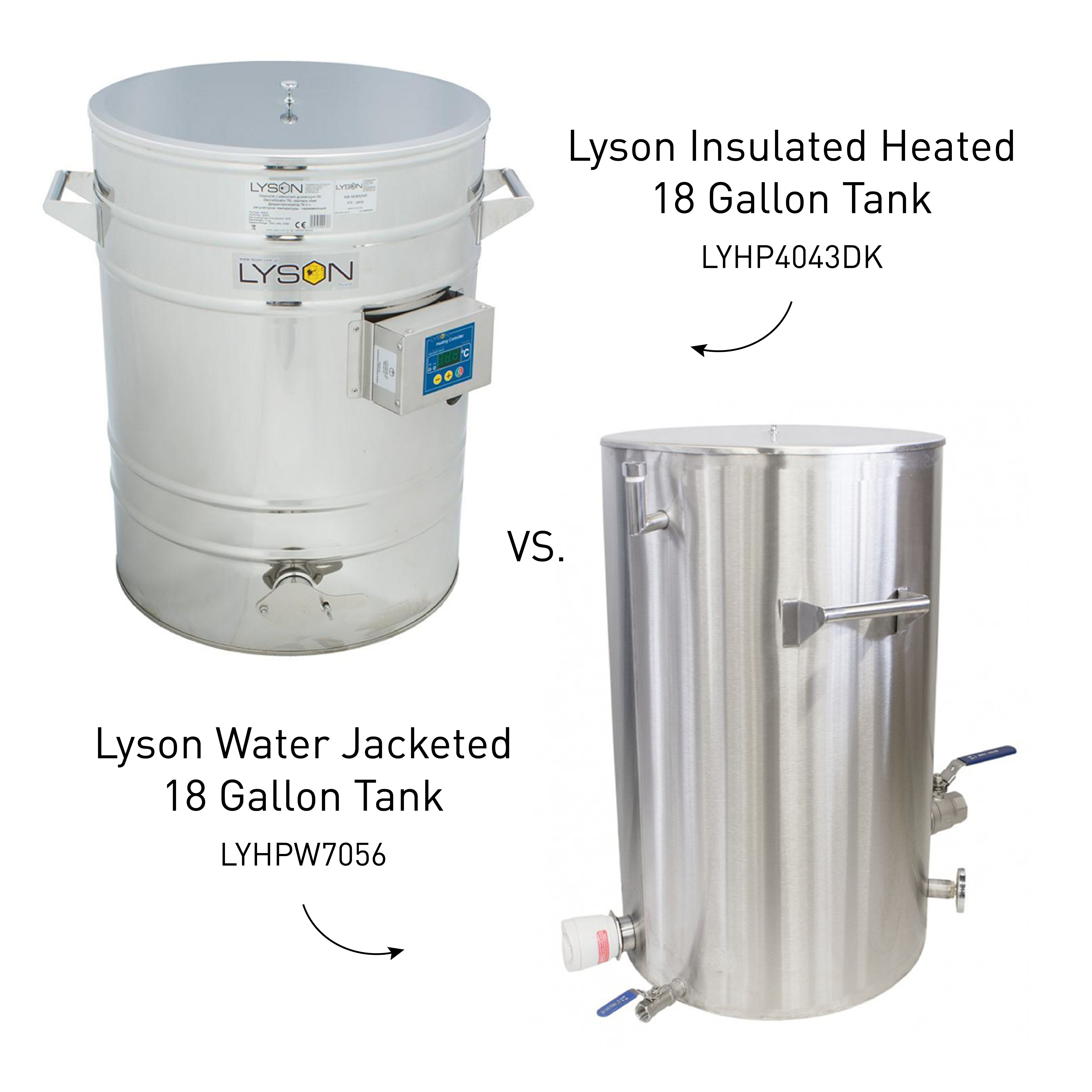One of the most common questions we get about extracting is, “Should I get a water jacketed tank, or a Lyson insulated/heated tank?” While both are meant to warm or decrystallize honey, there are distinct differences between them. So let’s get into it!
Both of these popular units provide nice and even heat to prevent hot spots, so the selection of which style to use depends on personal preferences and the honey bottling conditions. Factors such as available electrical power, where the unit will be stored, and whether water is readily available or not are all things to consider. Both styles of Lyson tanks come with sanitary fittings with honey gates. This allows the user to easily add a bottling valve or connect a hose in the future. A honey strainer or sieve can also be installed for filling on both units.
How does each tank heat up?
The Lyson 13 and 18 gallon Heated Tanks, LYHP4043AK and LYHP4043DK, use internal electric heating elements between the double walls and below the floor of the tank as well as insulation between the two tank walls and in the bottom. The unit requires 120V AC power which is normally more available than the water jacketed tank’s required 240V AC power. The temperature is digitally controlled to the desired temperature, between 86°F (30°C) to 131°F (55°C), which is set by the user on the control pad. These tanks only consume 175-250 watts of power, which means that the honey takes longer to warm. However, once warmed, the insulated jacket helps maintain the temperature with minimal power required.
The Lyson Heated 18 gallon Tank, LYHPW7056, as well as its 36 gallon older sibling, use a water jacket to heat the honey. The water surrounds the outside and underneath the honey in the double-walled tank. The unit requires 240V AC power for its powerful 2000-watt water heating element. The temperature is controlled by adjusting a knob on the immersion heater and monitoring a thermometer in the water jacket. Once this system is set, it usually doesn’t need a lot of adjustments. The tank does not come insulated, but we recommend adding a layer of bubble foil insulation to reduce heat loss.
Which requires more maintenance and which will last longer?
The water jacketed unit is heavier than the electric unless the water is removed. If you plan on moving the tank between batches of honey, the lighter electric unit may be better. The water must also be removed if the tank is at risk of freezing in its storage location.
Emptying and filling the water jacket can be messy with water spills, but the maintenance on the water jacket tank is easier. The water jacket immersion heater can be replaced, but it also may be more likely to have issues due to the risk of corrosion when submerged in water. If the heated/insulated tank’s thermometer or heating element fails, there is no repair option. It becomes an unheated insulated bottling tank. The water jacket heating elements tend to fail more frequently usually due to water quality issues, so we recommend using distilled water in the jacket to improve water chemistry. While not replaceable, the heated/insulated tanks have proven to be very reliable, and we have had only one electric element fail in the last three years.
Is creamed honey in your future?
The water jacketed unit is also capable of taking a creamer attachment in the future if creamed honey is ever produced. As part of the creaming process, the honey needs to be decrystallized. By gradually replacing the warm water in the jacket with cool water the honey can then be cooled prior to adding the seed honey. If the honey is too warm, the seed honey will melt.
Choose whatever tank fits your specific needs
The different designs give you the choice about how you want your honey to get warm and stay warm until bottling. Both tank designs will get the job done. The water jacketed tank will heat up faster, but may also lose some heat into the honey house. The insulated tank keeps the heat inside where it belongs but may take a little while to get to bottling temperature. The insulated tank uses less energy, if you’re planning to keep your honey warm for some time, and will never need to have its water drained or refilled. So which option is right for you? Whichever option fits better into your honey house and your extraction plans!

